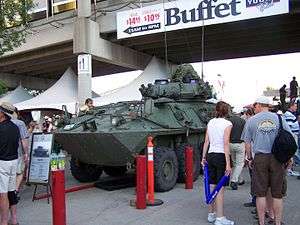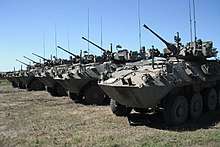Coyote Reconnaissance Vehicle
The Light Armoured Vehicle II (LAV II) Coyote is an armoured car built by General Dynamics Land Systems Canada for the Canadian Forces, for use in the light reconnaissance (scout) role.[1][2] It was also initially used in the role of medium tank trainer within armoured cavalry squadrons in the same way as the AVGP Cougar it replaced.[3] In service since 1996, the Coyote is a later generation of the LAV-25 and is of the same family as the Bison APC and the Australian ASLAV, as all are part of the Light Armoured Vehicle family produced by General Dynamics Land Systems - Canada and based on the MOWAG Piranha 8x8.[4]
| Coyote Reconnaissance Vehicle | |
|---|---|
 Canadian light armoured vehicle at the Calgary Stampede | |
| Type | Armoured fighting vehicle |
| Place of origin | Canada |
| Production history | |
| Designer | General Motors Diesel Division |
| Specifications | |
| Mass | 14.4 t (15.9 short tons) |
| Length | 6.39 m (21.0 ft) |
| Width | 2.50 m (8.2 ft) |
| Height | 2.69 m (8.8 ft) |
| Crew | 4 (driver, commander, gunner, surveillance suite operator) |
Main armament | 1 × M242 25mm chain gun |
Secondary armament | 1 × C6 7.62mm machine gun (coaxial) 1 × C6 7.62mm machine gun (pintle) 8 × grenade launchers (2 × cluster of 4) |
| Engine | Detroit Diesel 6V53T 275hp |
| Suspension | 8×8 wheeled, 4× drive |
Operational range | 660 km |
| Maximum speed | 100 km/h |
Design
Origins
The Coyote Reconnaissance Vehicle is a non-amphibious armoured reconnaissance vehicle based on the design of the LAV-25 and the MOWAG Piranha II. The Canadian Forces ordered 203 of the vehicles in 1993 to replace the Lynx reconnaissance vehicle, and all were delivered and entered service by 1996.[5][6][7] The Coyote originally came in three variants: the "Mast" variant with a mast-mounted surveillance system, a variant with a remote surveillance suite, and a basic reconnaissance/command post variant.[5][8][9]
Armament
The Coyotes mount a 25×137mm M242 Bushmaster chain gun and two 7.62×51mm NATO C6 general purpose machine guns in an electrically-driven turret. The turret also features a laser-warning receiver, and mounts a total of eight grenade launchers in two clusters capable of firing smoke and fragmentation grenades.[10][11] One of the machine guns is mounted coaxial to the main gun while the other is pintle-mounted in front of the crew commander's hatch.[12] The main gun is equipped with dual ammunition feeds that allow for separate weapons effects, selectable by the gunner/crew commander; the standard load is a belt of armour-piercing sabot rounds and a belt of HE-T explosive/fragmentation rounds. The main gun and coax machine gun are 2-axis stabilized. The turret is equipped with a laser rangefinder, but no ballistic computer; elevation and lead corrections are applied manually by the gunner using multi-stadia reticules in the day, thermal, and image intensification sights.
Protection
The standard armour of the Coyote protects against small arms fire, anti-personnel mines, and shrapnel, with add-on armour kits able to protect against larger projectiles.[13] The Coyote is equipped with a NBC detector suite consisting of a GID-3 chemical detector and an AN/VDR-2 radiation monitor. Each vehicle is also equipped with an NBC ventilated respirator system.[14][15]
Sensors
The mast-mounted surveillance variants are equipped with a mast-mounted surveillance system that can be raised to 10 meters above the ground.[16] This system includes the AN/PPS-5C MSTAR Version 3 surface surveillance radar and an electro-optical/infrared surveillance system with a long-range video camera and laser rangefinder.[17][18] The remote surveillance variant consists of two tripod-mounted systems capable of being deployed up to 200 meters away from the vehicle. The surveillance systems can detect tank-sized targets at up to 12 kilometres away, and large truck-sized targets at up to 24 kilometres. In good conditions the visual surveillance system can detect personnel up to 20 kilometres away.[19]
Mobility
The Coyote is powered by a Detroit Diesel 6V53T engine developing 275 horsepower (205 kW), and can reach speeds of 100 kilometres per hour (62 mph) on road. The Coyote has a maximum road range of 660 kilometres (410 mi). Each vehicle is equipped with a tactical navigation system that includes a GPS receiver, a digital compass system, and a backup dead-reckoning system.[20] A 15-tonne capacity hydraulic winch is also fitted to every vehicle to aid in self-recovery.[21] Unlike the LAV-25, the Coyote is equipped with extra fuel tanks in place of amphibious equipment.[22] The Coyote is air-transportable on Hercules C-130 aircraft but only with the turret removed first.[23]
Variants

Coyotes come in three variants: Command, Mast, and Remote. The Mast and Remote variants have a sophisticated suite of electronic surveillance equipment including radar, video, and infrared surveillance night vision devices. The mast variant has this equipment mounted on a 10-metre telescoping mast that can be extended to raise the surveillance suite out from behind cover. The remote variant of the Coyote has its surveillance suite mounted on two short tripods, which crew can deploy remotely using a 200-metre spool of cable.
When first purchased, the Coyote was designated for service with both the Regular Force and Reserve Force, with the Mast variants earmarked for the Regular units and the Remotes designated for the Reserves. Shortly after taking delivery of the vehicles, but before they were assigned to the Reserve units, all Coyotes were reassigned to the Regular Force.
Service history
Since the introduction of the Coyote to the Canadian Armed Forces, the vehicle has served national interest domestically and abroad. The Coyote served during the United Nations/ NATO missions in Bosnia and Herzegovina, Macedonia, Kosovo, and in Afghanistan. Domestically, it has been deployed during "Operation Grizzly" to Kananaskis to secure the 28th G8 summit, the 36th G8 summit, and the G-20 Toronto summit,[24][25] in addition to a number of domestic emergency response incidents. The Coyote is currently being retired and is being replaced by a mix of TAPV and LAV VI armoured vehicles.[26][27]
References
- "Exploring the Coyote". Department of National Defence. Archived from the original on 2 October 2007. Retrieved 18 September 2008.
- "Vetronics Engineering". General Dynamics Canada. Archived from the original on 29 April 2008. Retrieved 18 September 2008.
- Marteinson, John; McNorgan,Michael R. (2000). The Royal Canadian Armoured Corps: An Illustrated History. Montreal: Robin Brass Studio. ISBN 978-1896941172.
- Maas, Frank (Spring 2011). "The Success of the Light Armoured Vehicle" (PDF). Canadian Military History, Volume 20, No. 2. Archived (PDF) from the original on 8 August 2020. Retrieved 8 August 2020.
- Maas, Frank (Spring 2011). "The Success of the Light Armoured Vehicle" (PDF). Canadian Military History, Volume 20, No. 2. Archived (PDF) from the original on 8 August 2020. Retrieved 8 August 2020.
- "Coyote Armored Reconnaissance Vehicle | Military-Today.com". www.military-today.com. Retrieved 9 August 2020.
- "Exploring the Coyote". Department of National Defence. Archived from the original on 2 October 2007. Retrieved 18 September 2008.
- "Coyote LAV (Light Armored Vehicle) 8-Wheeled Battlefield Reconnaissance Vehicle". www.militaryfactory.com. Retrieved 9 August 2020.
- Government of Canada, National Defence (8 March 2013). "Coyote Armoured Patrol Vehicle | Canadian Army". www.army-armee.forces.gc.ca. Retrieved 9 August 2020.
- "The Canadian 8×8 Coyote Reconnaissance Vehicle". tanknutdave.com. Retrieved 9 August 2020.
- "Exploring the Coyote". Department of National Defence. Archived from the original on 2 October 2007. Retrieved 18 September 2008.
- "Coyote Armored Reconnaissance Vehicle | Military-Today.com". www.military-today.com. Retrieved 9 August 2020.
- Government of Canada, National Defence (8 March 2013). "Coyote Armoured Patrol Vehicle | Canadian Army". www.army-armee.forces.gc.ca. Retrieved 9 August 2020.
- "The Canadian 8×8 Coyote Reconnaissance Vehicle". tanknutdave.com. Retrieved 9 August 2020.
- "Exploring the Coyote". Department of National Defence. Archived from the original on 2 October 2007. Retrieved 18 September 2008.
- "Exploring the Coyote". Department of National Defence. Archived from the original on 2 October 2007. Retrieved 18 September 2008.
- "The Canadian 8×8 Coyote Reconnaissance Vehicle". tanknutdave.com. Retrieved 9 August 2020.
- "Canada orders ground surveillance radars". www.militaryaerospace.com. 27 July 2005. Retrieved 9 August 2020.
- "Coyote Armored Reconnaissance Vehicle | Military-Today.com". www.military-today.com. Retrieved 9 August 2020.
- "The Canadian 8×8 Coyote Reconnaissance Vehicle". tanknutdave.com. Retrieved 9 August 2020.
- "Exploring the Coyote". Department of National Defence. Archived from the original on 2 October 2007. Retrieved 18 September 2008.
- "Coyote LAV (Light Armored Vehicle) 8-Wheeled Battlefield Reconnaissance Vehicle". www.militaryfactory.com. Retrieved 9 August 2020.
- Barry Cooper, Mercedes Stephenson, Ray Szeto (2004). "Canada's Military Posture: An Analysis of Recent Civilian Reports" (PDF). The Fraser Institute. Archived from the original (PDF) on 11 November 2007. Retrieved 29 January 2008.CS1 maint: multiple names: authors list (link)
- Barr, Colonel David."The Kananaskis G8 Summit: A Case Study in Interagency Cooperation." journal.forces.gc.ca, 14 July 2008. Retrieved: 5 June 2010.
- Barr, Colonel David."Mosquitoes could be Huntsville weapon against protesters" thestar.com, 22 June 2010. Retrieved: 23 June 2010.
- "Light Armoured Vehicle Reconnaissance Surveillance System (LRSS)". Government of Canada. 1 February 2015.
- "Tactical armoured patrol vehicle". Department of National Defence. 13 December 2018. Retrieved 9 August 2020.
External links
| Wikimedia Commons has media related to Coyote Reconnaissance Vehicle. |